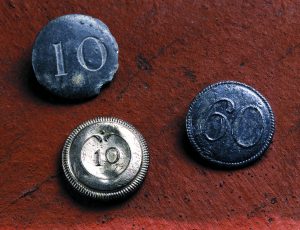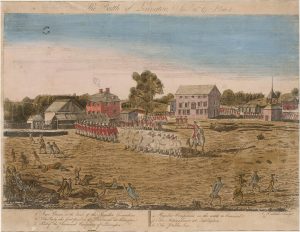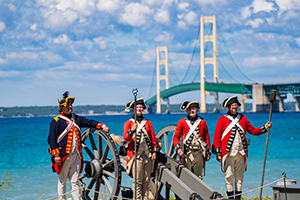

Like the 8th Regiment, the 10th had a long history. Originally raised in 1685 as the Earl of Bath’s Regiment, the unit served in the recurring European wars of the early 18th century. The regiment, like all other units in the British army, received its numerical designation in 1751. The 10th was ordered to North America in 1767, and took up station in Quebec. Then, in 1772, the regiment received orders to move into the Great Lakes posts. Accordingly, the 10th took up station at Fort Niagara, Fort Oswegatchie, Detroit, and Michilimackinac in mid-July. Captain John Vattas and two companies of soldiers made the long trip to Michilimackinac. The regiment’s new homes were some of the most remote outposts of the British empire, especially Michilimackinac. Ensign Jeremy Lister, assigned to Fort Niagara, thought that “it will not be very Pleasant for the Officers that go to Mishilamakenaque, as they will have about a fortnight’s traveling farther than Detroit, and when they get there nothing to look at, besides the woods, but a fort picketed round with wood and a House or two, which they will occupy.”
For the next two years the men of the 10th helped protect and regulate the fur trading networks centered on Michilimackinac. The men worked through the summer of 1772 and into 1773 to complete a new government storehouse inside the fort walls. Vattas ordered his troops to construct a boat launch with rollers to move canoes and bateaus in and out of the water in 1773, and the soldiers may also have replaced an entire wall of the fort.


The 10th Regiment remained in the Great Lakes region for only two years, being ordered back to Quebec in late 1774. From there, they traveled to Boston to join the growing army of British troops occupying the city as relations with the American colonists deteriorated. The light infantry and grenadier companies of the 10th formed part of the expedition to Concord on April 19, 1775, and were at the forefront of the fight there and at Lexington, the first battles of the American Revolution. The 10th was heavily engaged at Bunker Hill in June, and later participated in the New York, New Jersey, and Philadelphia campaigns.
John Vattas’ career came to an inglorious end outside Philadelphia in late 1777. By then a major, Vattas was in command of a small island fort in the Delaware River. When threatened by rebel soldiers, Vattas and another officer prohibited their men from firing and promptly abandoned the island. Vattas was court-martialed for abandoning the post to the enemy, and many other officers commented on his cowardice. He was allowed to sell his commission and retire, albeit in disgrace, in 1778.
After three years on the front lines of the American Revolution, by late 1778 the 10th Regiment was worn out and ordered to return to England. The regiment served in Egypt and Europe during the Napoleonic Wars, and spent several years in the mid-19th century in India and Japan. Today, the 10th Regiment lives on as part of the Royal Anglian Regiment in the modern British Army.









